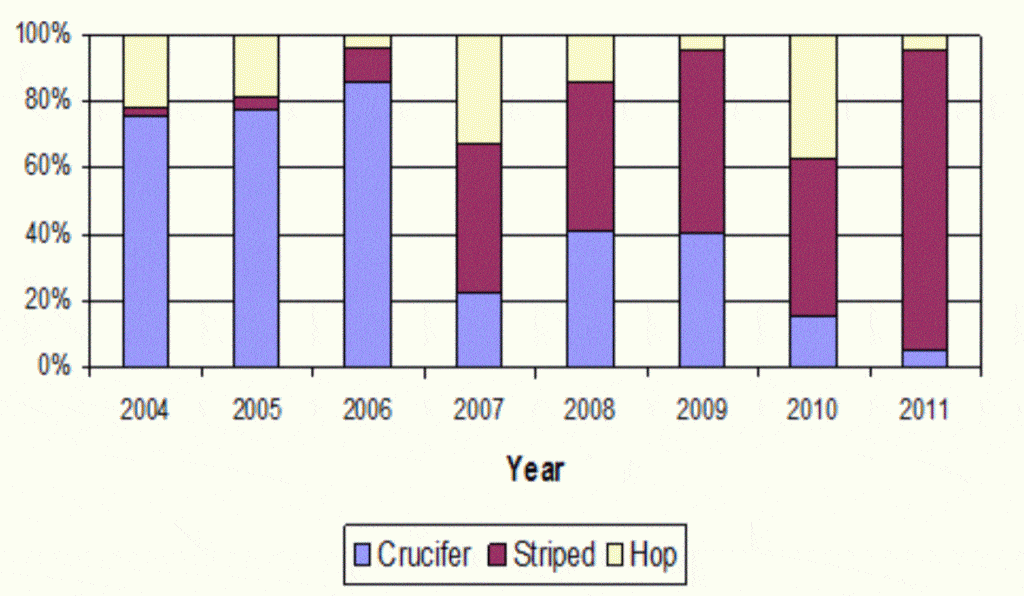Key Result
Once rarely encountered in the canola fields of southern Canada, the survey found that P. striolata is becoming more numerous in its range of occurrence across the Prairies (including the Peace River region of British Columbia/Alberta, central Alberta, central Saskatchewan, and much of Manitoba). However P. cruciferae still remains the predominant flea beetle in fields with high numbers of flea beetles.
Project Summary
The crucifer flea beetle Phyllotreta cruciferae (Goeze), most frequently found in the southern Canadian prairie regions, and Phyllotreta striolata (Fab.), the striped flea beetle, which has traditionally been found in greatest numbers along the northern Parkland of the prairies and in the Peace River Region of Alberta, are the two most common flea beetles in Canadian canola fields. Psylliodes punctulata Melsh., the hop flea beetle, occurs on low numbers across the prairies, while several other flea beetle species are found in prairie canola in minor amounts. When insecticides for the control of flea beetles in canola were developed, they were tested primarily against P. cruciferae, historically the most numerous of the three principal flea beetle species. Laboratory tests have shown that neonicotinoid insecticides that have replaced lindane seed treatments may not be as effective in controlling P. striolata as they are against P. cruciferae. In the current study, in 2007 a preliminary survey was conducted at 25 locations across the Canadian prairies to determine the numbers and distribution of the flea beetle species most commonly found in prairie canola fields. The survey was expanded to 34 sites in 2008. In 2009 the CARP project was initiated and 44 sites were surveyed, in 2010 that number was increased to 98 sites, and 99 sites were sampled across the Canadian prairies and North Dakota in 2011. Flea beetles were monitored using series of 13.0×7.5cm yellow sticky traps placed in or near canola fields and changed regularly for periods ranging from one week in spring to the entire summer, but averaging three to four weeks in May-June, starting at the time of canola emergence. Traps were examined and the number and species of flea beetles on the traps were identified.

In total, over the five years 11,180 traps were retrieved from 300 site-year locations and examined for flea beetle species and numbers. While population development, flea beetle peak numbers and species were site-specific and varied with location, in general flea beetle species distribution followed traditional patterns. P. striolata was common in northern areas of Canada, and P. cruciferae wasthe main beetle captured near the 49th parallel. However, compared to results from surveys conducted in the 1970s, the proportion of P. striolata numbers in northern areas has increased dramatically, especially in the Peace River region, and population shifts have occurred. P. punctulata has been displaced by P. striolata as the most common flea beetle in the Peace River region of British Columbia/Alberta. P. striolata has displaced P. cruciferae as the most frequently encountered flea beetle in central Alberta, central Saskatchewan, and much of Manitoba. And once rarely encountered in the rape/canola fields of southern Canada, P. striolata is now found there in increasing numbers. Although the survey found that P. striolata is becoming more numerous in its range of occurrence across the prairies, P. cruciferae still remains the predominant flea beetle in fields with high numbers of flea beetles. Several species of Chaetocnema, a flea beetle not recognized as a pest of Canadian canola, were found in increasing locations and numbers in the survey.





